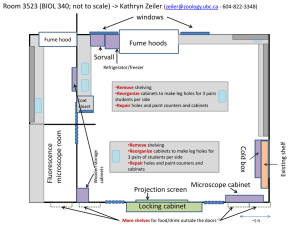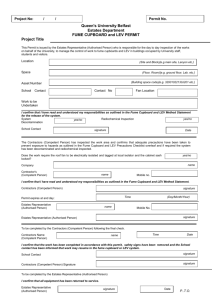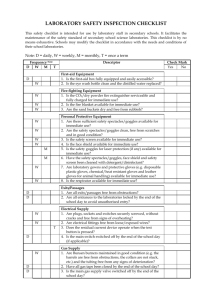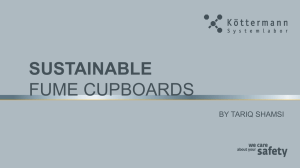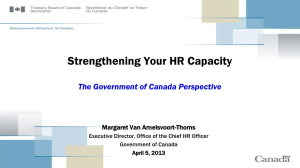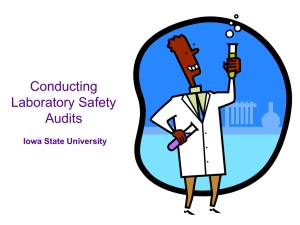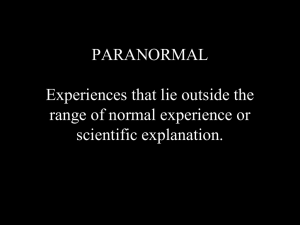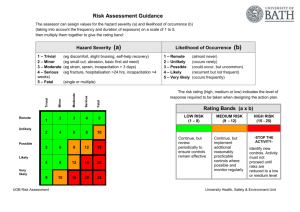Guidance on the Use and Testing of Local
advertisement
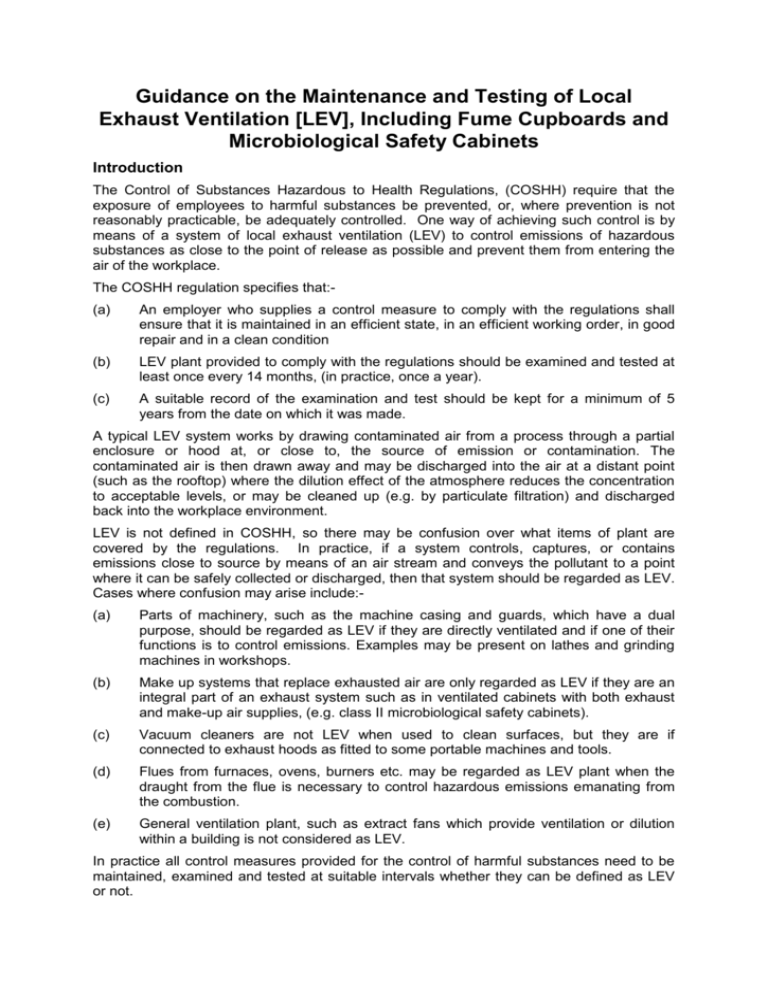
Guidance on the Maintenance and Testing of Local Exhaust Ventilation [LEV], Including Fume Cupboards and Microbiological Safety Cabinets Introduction The Control of Substances Hazardous to Health Regulations, (COSHH) require that the exposure of employees to harmful substances be prevented, or, where prevention is not reasonably practicable, be adequately controlled. One way of achieving such control is by means of a system of local exhaust ventilation (LEV) to control emissions of hazardous substances as close to the point of release as possible and prevent them from entering the air of the workplace. The COSHH regulation specifies that:(a) An employer who supplies a control measure to comply with the regulations shall ensure that it is maintained in an efficient state, in an efficient working order, in good repair and in a clean condition (b) LEV plant provided to comply with the regulations should be examined and tested at least once every 14 months, (in practice, once a year). (c) A suitable record of the examination and test should be kept for a minimum of 5 years from the date on which it was made. A typical LEV system works by drawing contaminated air from a process through a partial enclosure or hood at, or close to, the source of emission or contamination. The contaminated air is then drawn away and may be discharged into the air at a distant point (such as the rooftop) where the dilution effect of the atmosphere reduces the concentration to acceptable levels, or may be cleaned up (e.g. by particulate filtration) and discharged back into the workplace environment. LEV is not defined in COSHH, so there may be confusion over what items of plant are covered by the regulations. In practice, if a system controls, captures, or contains emissions close to source by means of an air stream and conveys the pollutant to a point where it can be safely collected or discharged, then that system should be regarded as LEV. Cases where confusion may arise include:(a) Parts of machinery, such as the machine casing and guards, which have a dual purpose, should be regarded as LEV if they are directly ventilated and if one of their functions is to control emissions. Examples may be present on lathes and grinding machines in workshops. (b) Make up systems that replace exhausted air are only regarded as LEV if they are an integral part of an exhaust system such as in ventilated cabinets with both exhaust and make-up air supplies, (e.g. class II microbiological safety cabinets). (c) Vacuum cleaners are not LEV when used to clean surfaces, but they are if connected to exhaust hoods as fitted to some portable machines and tools. (d) Flues from furnaces, ovens, burners etc. may be regarded as LEV plant when the draught from the flue is necessary to control hazardous emissions emanating from the combustion. (e) General ventilation plant, such as extract fans which provide ventilation or dilution within a building is not considered as LEV. In practice all control measures provided for the control of harmful substances need to be maintained, examined and tested at suitable intervals whether they can be defined as LEV or not. The types of LEV encountered in the University may include: those fitted to individual workshop machines or scientific instruments exhaust hoods providing cover for such areas as instrument and gas-cylinder bays portable systems used in workshops or for on-site welding laboratory fume cupboards. microbiological safety cabinets There are specific airflow velocity limits which must be achieved by fume cupboards and microbiological safety cabinets. These are provided later in this guidance for microbiological safety cabinets and on the test report form for fume cupboards available from this website [see below]. Such measurements are difficult to perform and standardise for other types of LEV. In these cases, smoke tests will adequately indicate whether efficient removal of contaminated air from the breathing zone is being achieved. Fume Cupboards: Negative pressure Cupboards The fan is positioned near the exterior outlet, usually on the roof of the building. The column of air is thus pulled up the duct under negative pressure so any break in the duct-work will result in the inward movement of air and entrained pollutants are contained. One or more cupboards may be served by the same outflow duct and the same extract fan. The arrangement for each fume cupboard must be ascertained before testing takes place. Maintenance and Testing [1] Checks to be made by staff within the School concerned Basic inspection This should be made to ensure that the cupboard is functioning correctly with the primary aim of identifying potential problems so they may be rectified before they lead to a deterioration in performance with a subsequent loss of user protection. Laboratory supervisors should nominate someone to carry out the following on a weekly basis:- Check that air flow is into the cupboard Check that any alarms fitted are working Check that any flow meters are functional Any defects should be reported to ESTAT for remedial action Functional Check This should be made on a regular basis as determined by risk assessment and also when there is reason to suspect that the function of the fume cupboard may be impaired. This includes checking the velocity of air flow into the cabinet and the function of all warning systems on the cupboard. The Fume Cupboard Test Procedure and Report form for this can be downloaded as a Word document from this website: [2] Checks to be made by ESTAT [A] Annual check. ESTAT will make an annual check of the performance and integrity of the fume cupboard and exhaust duct systems to comply with the requirements of COSHH regulations. Prior to the inspection Schools must comply with the requirements given in the OSHEU document, ‘Procedures for Fume Cupboard Maintenance’, which is available on this website. The results of these tests will be entered both onto a central ESTAT register and the record sheet attached to each fume cupboard. They will also be reported to the appropriate person in the School concerned. It is the responsibility of the School to take action to ensure that any noted defects are remedied in collaboration with ESTAT as soon as is reasonably practicable. Major defects may require that the fume cupboard be taken out of service until they are corrected. [B] Smoke tests In some cases, it will also be necessary to carry out a smoke test on the fume cupboard as a result of concerns about the integrity of its function. The need for this may be indicated by such things as: detection of persistent smells outside the cupboard the results of environmental monitoring for the presence of chemicals in the air outside the cupboard visible damage to the cupboard or duct system. Smoke tests can be used to investigate a number of problems, such as: irregular air-flow and eddy characteristics resulting in air movement out of the cupboard, the possible negative effects of equipment on airflow , the possible negative effect of heat sources within the cupboard on airflow leakage from the cupboard or ducting. If you consider that a smoke test may be required, contact ESTAT Microbiological Safety Cabinets Microbiological safety cabinets are used specifically to reduce the risk of biological contamination and infection of workers using materials which are, or may be, infected with hazardous pathogens. Class I: An open-fronted cabinet through which air is drawn to minimise aerosol escape and is filtered through a high efficiency particulate air filter (HEPA) before discharge to the laboratory air or ducting to the exterior of the building. The cabinet protects the worker from contamination but not the sample being worked on. They are suitable for Hazard Group 2 and most Hazard Group 3 pathogens. (See ACDP document, "Categorisation of pathogens according to hazard group and level of containment".) Class II: An open fronted cabinet which is flushed with a downward draught of sterile air which is HEPA filtered and re-circulated. Some air is drawn in through the front of the cabinet and a corresponding amount is discharged to the outside through a HEPA filter. Both worker and work are protected. Suitable for Group 2 and most Group 3 agents. Class III: A totally enclosed cabinet in which the worker manipulates the sample by means of gloves attached to ports. Both the incoming and outgoing air is HEPA filtered. There is a high degree of protection for both worker and work. Suitable for pathogens of hazard groups 3 and 4. Another type of cabinet often encountered in laboratories, especially microbiological laboratories, is the laminar airflow cabinet. However, laminar flow cabinets are not safety cabinets. The principle of operation is totally the reverse to safety cabinets in that sterile air is directed through a HEPA filter from the back of the work surface, over the sample and out of the front of the cabinet. The purpose is to protect the work not the worker, and they are intended for the manipulation of non-contaminated samples for checking sterility or for the preparation of sterile materials Laminar flow cabinets are commonly and wrongly used to avoid contamination of potentially pathogenic cultures or other infective material during sub-culture and other manipulations which should be carried out on the laboratory bench under Level 2 containment conditions and efficient aseptic techniques. It is impossible to manipulate liquid samples without generating aerosols, or dry samples without generating particles; using a laminar flow cabinet for these purposes directs a stream of aerosols or particles directly at the user and beyond into the workplace. Maintenance and testing Specific and specialist tests are carried out on installation of microbiological safety cabinets by the commissioning engineer according to British Standards BS 5726 and BS EN 12469:2000 which deals with operator protection factors. An agent of the client should witness the commissioning process and ensure that the supplier has adequately demonstrated compliance with the British Standard. In most cases, a maintenance contract is serviced by the supplier whose engineers will carry out operator protection factor tests at regular intervals and when filters are changed. A maintenance and monitoring scheme should operate at three levels:1. Before each use: Users should be trained to make simple checks whenever the cabinet is used. Defects must be reported. - Fan is working and airflow meter is indicating safe - There are no obvious defects - The lights are on and the alarm is not sounding - The front screen is in place where appropriate 2. Weekly: More formal checks must be made at weekly intervals to ensure that the cabinet is working properly and is being used properly. - 3. Ensure that the flow of air is inward for Class I and Class II cabinets Ensure there is also a down flow in Class II cabinets Examine cabinet and any visible ducting for signs of damage or wear Check all alarms Check fan setting Every 3-6 months: depending on usage, the cabinet should be thoroughly checked and serviced by a competent engineer. This will usually constitute part of a formal service contract. The cabinet must be made safe beforehand by thorough disinfection or fumigation and a "permit to work" certificate stuck on it. Records Results of the formal weekly tests and engineer's examinations should be recorded and kept for at least 5 years. Air Flow Measurements Mean inward airflow measurements in Class I cabinets may be made in the same way as those for chemical fume cupboards (see later). In Class II cabinets, down flow measurements are fairly straightforward but inward flow is more difficult as there is a velocity gradient from top to bottom of the aperture. The revised British Standard BS EN 12469:2000 gives specifications for the different classes of cabinet:Class I: Inward airflow of 0.7 to 1.0 m/s (readings should not deviate more than 20% from mean) Class II: Minimum inward airflow - 0.4 m/s Down flow - 0.25 to 0.5 m/s If necessary, smoke tests may be employed to ensure that airflow is inwards over the whole of the front aperture.
